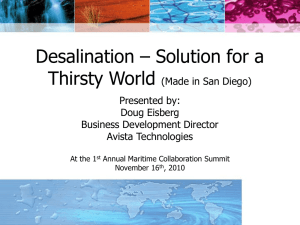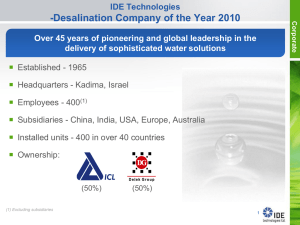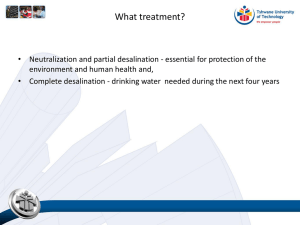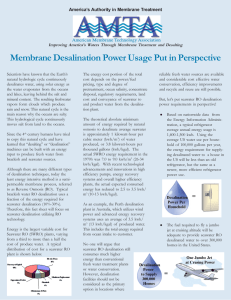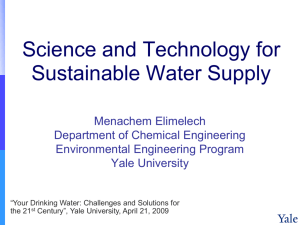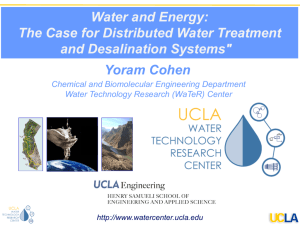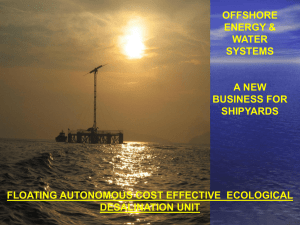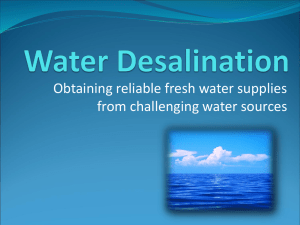Forward Osmosis: potential applications and challenges
advertisement
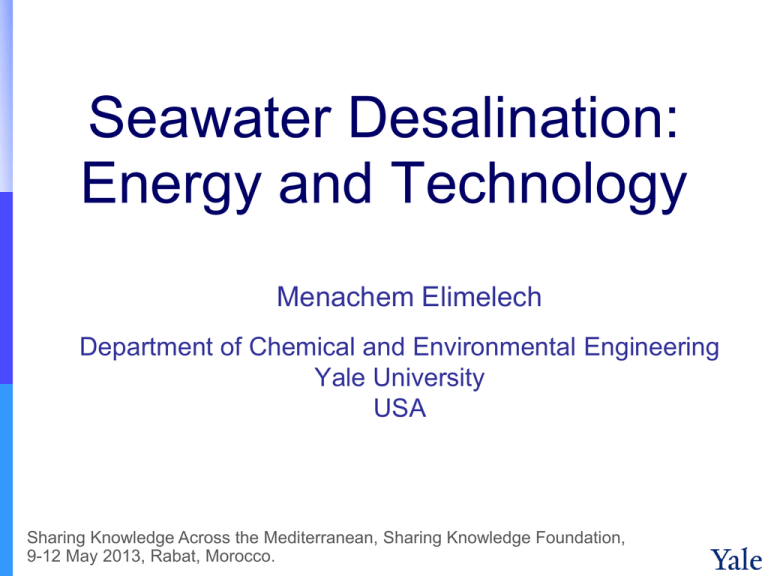
Seawater Desalination: Energy and Technology Menachem Elimelech Department of Chemical and Environmental Engineering Yale University USA Sharing Knowledge Across the Mediterranean, Sharing Knowledge Foundation, 9-12 May 2013, Rabat, Morocco. The “Top 10” Global Challenges for the New Millennium 1. Energy 2. Water 3. 4. 5. 6. 7. 8. 9. 10. Food Environment Poverty Terrorism and War Disease Education Democracy Population Richard E. Smalley, Nobel Laureate, Chemistry, 1996, MRS Bulletin, June 2005 The Water-Energy-Food Nexus 1. Energy 2. Water 3. Food 4. 5. 6. 7. 8. 9. 10. Environment Poverty Terrorism and War Disease Education Democracy Population Richard E. Smalley, Nobel Laureate, Chemistry, 1996, MRS Bulletin, June 2005 Water Scarcity is a Global and Regional Challenge We Consume Massive Amounts of “Virtual Water” through Food and Products 120 L for one glass of wine 70 L of water for one apple 900 L for 1 kg of potato flakes 3,900 L for 1 kg of chicken meat 140 L for 1 cup of coffee 2,400 L of water for one hamburger! 2,700 L for 1 cotton shirt 16,600 L for 1 kg of leather Agriculture Requires Huge Amounts of Water Agriculture Requires Huge Amounts of Water 3 Estimated Water Use (km /yr) 4000 3000 Reservior Losses Municipal Industry Agriculture 2000 1000 0 1900 1920 1940 1960 1980 Year Hoover, L.A. et al., Environmental Science & Technology, 45, 2011, 9824–9830. 2000 How Do We Increase Available Water Supply? Water conservation, repair of infrastructure, and improved catchment and distribution systems ― improve use, not increasing supply Increasing water supply can only be achieved by: Desalination of seawater Reuse of wastewater NATIONAL RESEARCH COUNCILOF THE NATIONAL ACADEMIES 2008, Washington, D.C. March 2008 Seawater Reverse Osmosis (SWRO): The State-of-the-Art Technology Seawater Desalination Offers a seemingly unlimited, steady supply of high-quality water Production of fresh water without impairing natural fresh water ecosystems More energy intensive (~ 3 to 4 times) compared to conventional technologies for the treatment of fresh water Concerns about the potential environmental impacts of large-scale SWRO plants What is the Current Energy Efficiency of Desalination and Can it be Improved? Major Reductions in Energy Use by SWRO in the Past 20 Years Minimum Theoretical Energy of Desalination Reversible thermodynamic process Independent of the technology or mechanism of desalination Minimum theoretical energy (typical seawater, 35,000 ppm): 0% recovery: 0.76 kWh/m3 50% recovery: 1.06 kWh/m3 Energy Consumption in the RO Process V P p Vp s H s Energy Consumption in the RO Process Energy Consumption in SWRO Desalination For 50% recovery: Theoretical minimum energy (thermodynamics): 1.06 kWh/m3 For best SWRO, RO consumes: ~ 2 kWh/m3 Overall energy consumption for the entire SWRO plant for recently constructed plants: 3 - 4 kWh/m3 RO Consumes ~ 2 kWh/m3: Where is the Rest of Energy Expended? Pre-treatment Increased pressure to compensate for fouling Post-treatment (boron and chloride removal for agricultural water) Intake, discharge Can Novel Materials Reduce Energy Consumption? How Can We Reduce the Energy Use in the RO Stage? Hot Area of Research: High Permeability (Flux) RO Membranes..... “Quantum Leap In Desalination” Rationale: High permeability membranes would reduce the required applied pressure and hence reduce energy consumption Aligned Nanotubes as High Flux Membranes for Desalination Bio-inspired (Aquaporin) High Flux Membranes for Desalination But…Energy is Governed by the Osmotic Pressure of the Concentrate Must operate at PH > C High Permeability Membranes will Have a Negligible Effect With current membranes, PH is 10-20% above C Thin-Film Composite Polyamide Membranes are Prone to Fouling Relatively hydrophobic Rough surface Contain carboxyl groups Hence, prone to fouling Also sensitive to oxidants (like chlorine) Hence, prone to biofouling Reducing RO Membrane Fouling and Biofouling is the Key Fouling resistant membranes Chlorine (oxidant) resistant membranes Improve reliability and energy efficiency of RO Reduce the use of chemicals for cleaning Reduce pretreatment energy and costs Are There Innovative Technologies that can Reduce Energy Demand? The Forward Osmosis Process Membrane Feed Water Diluted Draw Solution Draw Solution Recovery Process Concentrate Concentrated Draw Solution Energy Input Product water FO Desalination with Thermolytic Draw Solution: Ammonia Carbon Dioxide Nature, 452, (2008) 260 Low-Grade Heat McCutcheon et al., Desalination, 174 (2005) 1-11. Thermolytic Draw Solution: NH3/CO2 NH3(g) CO2(g) NH3(g) CO2(g) NH4HCO3(aq) (NH4)2CO3(aq) NH4COONH2(aq) HEAT Waste Heat Geothermal Power (3.5 km) Solar Thermal Much of sub-Saharan Africa receives solar radiation of the order of 6-8 kWh/m2/day--some of the highest amounts of solar radiation in the world. Recommendations “Although several options currently exist to augment freshwater sources—including the treatment of low-quality local water sources, water recycling and reuse, and water conservation— these options alone will not be enough to meet this need.“ “While seawater desalination must be considered after all other options have been implemented, it should be viewed as a crucial component in the portfolio of water supply options.” “For water-scarce countries that already implement all other measures for freshwater generation, desalination may serve as the only viable means to provide water supply.” Elimelech and Phillip, Science, 333 (2011) 712-717. Acknowledgments Current and former research group at Yale Funding: National Science Foundation, Office of Naval Research, Department of Energy, US EPA, Cornell-KAUST


